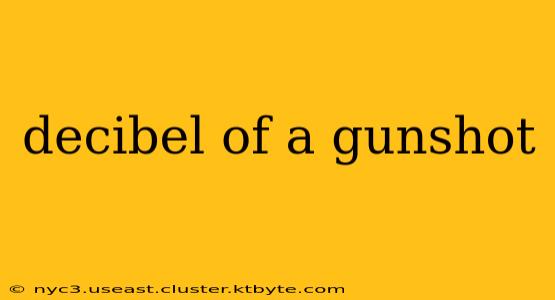The loud bang of a gunshot is instantly recognizable, but just how loud is it, exactly? Understanding the decibel level of a gunshot is crucial for appreciating its potential impact on hearing health and the surrounding environment. This post delves into the specifics, exploring the factors influencing gunshot noise and the dangers associated with such intense sound.
Decibel Levels: A Range of Impacts
The decibel (dB) scale is logarithmic, meaning each 10-dB increase represents a tenfold increase in sound intensity. A gunshot's decibel level isn't a single number; it varies considerably depending on several factors:
-
Type of firearm: A small-caliber pistol will produce a significantly lower decibel reading than a high-powered rifle. Larger cartridges generate more explosive force, resulting in a louder report.
-
Ammunition type: The type of ammunition used also plays a critical role. Different bullet designs, powder charges, and even the casing material can affect the sound intensity.
-
Muzzle device: Firearms equipped with suppressors (often mistakenly called silencers) substantially reduce the decibel level. While they don't eliminate the sound entirely, they significantly dampen it.
-
Environment: The surrounding environment can influence the perceived loudness. Open spaces allow sound waves to disperse more readily, while enclosed areas such as indoor ranges or urban canyons can cause sound reflections and amplification, leading to higher perceived decibel levels.
Generally, gunshots range from approximately 140 dB to over 175 dB. To put this into perspective:
-
140 dB: Similar to a jet engine taking off at close range. Exposure at this level can cause immediate and permanent hearing damage.
-
175 dB: Exceeds the threshold of pain and can cause immediate and severe hearing loss. This level can also cause physical damage to the eardrum and other structures of the ear.
The Dangers of Gunshot Noise
Exposure to high decibel levels, even for short durations, presents serious health risks. The intense sound waves can cause:
-
Temporary or permanent hearing loss: Damage to the delicate hair cells within the inner ear, responsible for transmitting sound signals to the brain. This can result in tinnitus (ringing in the ears), hyperacusis (increased sensitivity to sound), and difficulties understanding speech.
-
Noise-induced hearing loss (NIHL): A progressive and irreversible type of hearing loss caused by prolonged exposure to loud noise.
-
Acoustic trauma: Sudden, severe hearing loss or other damage to the auditory system caused by exposure to an extremely loud sound, such as a gunshot.
Protective Measures
Protecting yourself from the hazardous effects of gunshot noise is crucial. This includes:
-
Hearing protection: Always wear appropriate hearing protection, such as earmuffs or earplugs, when firing a firearm or near a firing range. Consider the Noise Reduction Rating (NRR) when selecting hearing protection.
-
Distance: Maintain a safe distance from the point of discharge whenever possible.
-
Suppressors: The use of suppressors can help reduce the sound levels generated by firearms.
-
Environmental considerations: Be mindful of the surrounding environment when firing a firearm. Avoid enclosed spaces and consider the potential for noise pollution to others.
Conclusion
Understanding the decibel levels associated with gunshots underscores the importance of hearing protection and safe firearm handling practices. The potential for hearing damage is significant, and the information presented here highlights the necessity of responsible gun ownership and noise awareness. Prioritizing hearing safety should always be a paramount concern for anyone handling firearms or working in environments where exposure to loud noises is common.

